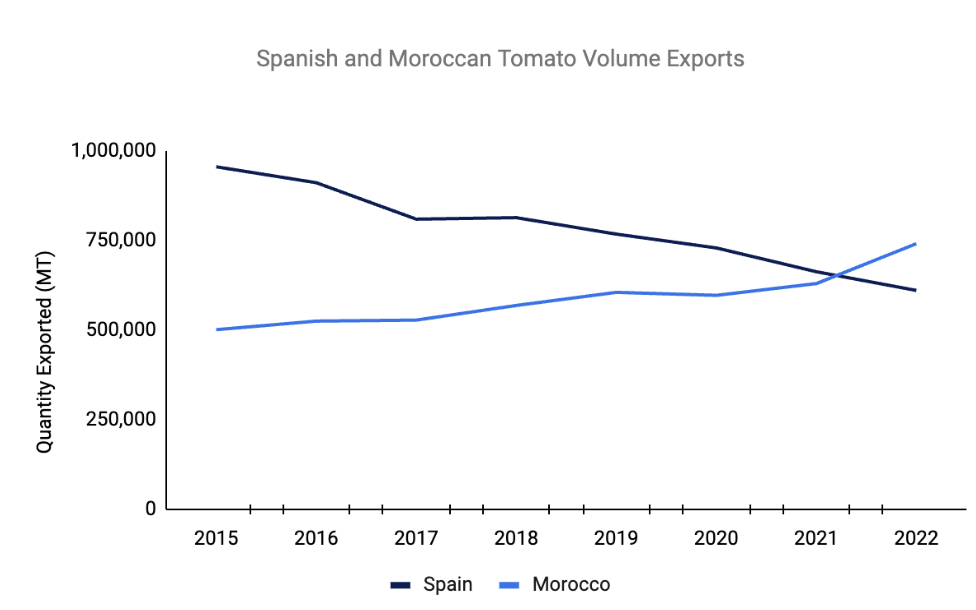Increase in Moroccan Tomato Imports to the EU Menace Spanish Exports

The accelerated growth of imports from Morocco and the EU's crop protection and packaging policies threatens the European tomato sector, particularly in Spain, where exports have decreased. The EU tomato imports from Morocco have gone from 365.6 thousand mt since the first year the EU imported tomatoes from Morocco in 2013 to 557.2 thousand mt in 2022. If including the UK, the amount imported would be 702 thousand mt in 2022.
At the same time, the latest trade data from the Ministry of Agriculture in Spain show that the tomato volumes exported by Spain have fallen below those registered in 2016/2017 and the average of the last five campaigns. In fact, exports of Spanish tomatoes have fallen by 25% in four years. Moreover, despite a second consecutive season in the area planted with winter tomatoes, Spanish tomato exports have continued to fall in volume until February of this year.
According to a complaint by the Spanish Federation of Associations of Exporting Producers of Fruits, Vegetables, Flowers, and Live Plants (FEPEX), there are two factors threatening tomato production in Europe. One is the uncontrolled growth of tomato imports from Morocco, and the other is the community policy regarding phytosanitation and packaging derived from the Farm to Fork Strategy. As a result, Fepex has already requested the repeal of regulations proposed by the European Commission and exceptional aid of up to 10% of the value of the tomatoes sold.
FEPEX’s trade and phytosanitary complaints of Moroccan tomato imports come after the summer forecast estimates of a 5% downward trend due to the lower production of tomatoes. The decrease is due to low temperatures that have caused a drop in Andalusian output. Besides the weather, record high production costs for greenhouse vegetables in Spain has been registered. Furthermore, due to the continuous inflationary costs primarily driven by the energy crisis, inputs and supplies such as electricity, water, agricultural diesel, and plastic consumables have seen an unprecedented price increase. Consequently, the average cost of greenhouse tomatoes has increased by 34% over the last two campaigns.
Resulting of the decreased production and rising import volumes from Morocco, Spain has been losing its market share considerably in Europe. In a decade, it has gone from exporting 1 million mt to 630 thousand mt, about 37% less.

Source: Tridge
Moroccan tomato imports have continued growing in the last decade, while tomato imports from European Union countries have decreased significantly. In 2022, the value of Spain’s tomato purchases from other countries broke records, reaching EUR 206.3 million–with Morocco as the main country of origin with half of the total value, followed by Portugal and the Netherlands. While Spanish tomato exports have fallen by 25% in four years, in the same period, the number of imports from Morocco of this product has increased by 51.9%.
The FEPEX complaint is more visible in the British market, where the loss of competitiveness of the EU tomato production is clearly observed. In 2022, Spanish tomato exports to the United Kingdom have fallen from 143 thousand mt to 70.7 thousand mt, according to United Nations Statistics Division data.
Farmers in Spain have been denouncing the disadvantage for some time now. They claim that the same conditions are not imposed on agricultural products imported from third non-European countries as they are on local producers, mainly in relation to the use of certain phytosanitary products. A request that has been repeated in the agricultural sector for a long time since it not only affects tomatoes but also leaves all types of crops at a disadvantage. Farmers affirm that they cannot compete with the conditions of the non-EU countries, where cheaper and more effective phytosanitary products can be used.






